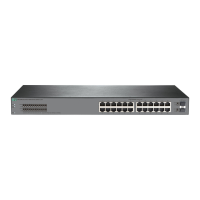133
stp global config-digest-snooping
stp cost
Use stp cost to set the path cost of a port.
Use
undo stp cost to restore the default.
Syntax
stp [ instance instance-list | vlan vlan-id-list ] cost cost-value
undo stp [ instance instance-list
| vlan vlan-id-list ] cost
Default
The device automatically calculates the path costs of ports in each spanning tree based on the
corresponding standard.
Views
Layer 2 Ethernet interface view
Layer 2 aggregate interface view
Predefined user roles
network-admin
Parameters
instance instance-list: Specifies a space-separated list of up to 10 MSTI items. Each item
specifies an MSTI or a range of MSTIs in the form of
instance-id1 [ to instance-id2 ]. The
value for
instance-id2 must be equal to or greater than the value for instance-id1. The
value range for the
instance-id argument is 0 to 4094, and the value 0 represents the CIST.
vlan vlan-id-list: Specifies a space-separated list of up to 10 VLAN items. Each item
specifies a VLAN or a range of VLANs in the form of
vlan-id1 [ to vlan-id2 ]. The value for
vlan-id2 must be equal to or greater than the value for vlan-id1. The value range for the
vlan-id argument is 1 to 4094.
cost-value: Specifies the path cost of the port, with an effective range that varies by path cost
calculation standard that is used.
• When the IEEE 802.1d-1998 standard is selected for path cost calculation, the value range for
the
cost argument is 1 to 65535.
• When the IEEE 802.1t standard is selected for path cost calculation, the value range for the
cost argument is 1 to 200000000.
• When the private standard is selected for path cost calculation, the value range for the
cost
argument is 1 to 200000.
Usage guidelines
Path cost is an important factor in spanning tree calculation. Setting different path costs for a port in
MSTIs allows VLAN traffic flows to be forwarded along different physical links. This results in
VLAN-based load balancing.
The path cost setting of a port can affect the role selection of the port. When the path cost of a port is
changed, the system calculates the role of the port and initiates a state transition.
If this command is configured in Layer 2 Ethernet interface view, it takes effect only on that interface.
If this command is configured in Layer 2 aggregate interface view, it takes effect only on the
aggregate interface.

